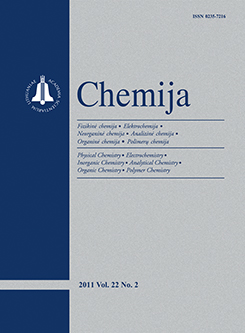Chemija / Chemistry
 ISSN 0235-7216 ISSN 2424-4538 (online) |
2012 m. Nr. 4 Liquid-liquid extraction and spectrophotometric characterization of some new ternary ion-association complexes of gallium(III) and indium(III)
Complex formation and liquid-liquid extraction were studied in systems containing M(III) (M = gallium or indium), 4-(2-pyridylazo)resorcinol (PAR), tetrazolium salt (TZS), water and chloroform. Two different TZS were used: 2-(4-iodophenyl)-3-(4-nitrophenyl)-5-phenyl-2H-tetrazolium chloride (INT) and 3-(2-naphtyl)-2,5-diphenyl-2H-tetrazolium chloride (Tetrazolium Violet, TV). The optimum conditions for extraction of Ga(III) and In(III) as ternary complexes with the general formula (TZ+)[M(PAR)2] were found: pH, shaking time, concentration of PAR and concentration of TZS. Some key constants (constants of extraction – Kex, constants of association – β, constants of distribution – KD) and analytical characteristics (molar absorptivities – εmax, Sandell’s sensitivities – SS, limits of detection – LOD, limits of quantification – LOQ, etc.) were determined. The stability of the obtained ionic associates were compared with literature data for similar ternary compounds, in which TZ+ is 2,3,5-triphenyl-2H-tetrazolium or 3-(4,5-dimethylthiazol-2-yl)-2,5-diphenyl-2H-tetrazolium. A conclusion was made that TV forms the most stable (Log β(Ga) = 5.38, Log β(In) = 4.58) and intensively coloured complexes (ε510(Ga) = 9.6 × × 104 L mol–1 cm–1, ε515(In) = 7.9 × 104 L mol–1 cm–1). (INT+)[In(PAR)2] is fairly unstable and this fact can be of importance for the development of an INT-based simple procedure for Ga(III)/In(III) separation.
Keywords: gallium, indium, 4-(2-pyridylazo)resorcinol, tetrazolium salts, solvent extraction |
Issues:
2017 - Vol.28 No. 1, No. 2, No. 3, No. 4 2016 - Vol.27 No. 1, No. 2, No. 3, No. 4 2015 - Vol.26 No. 1, No. 2, No. 3, No. 4 2014 - Vol.25 No. 1, No. 2, No. 3, No. 4 2013 - Vol.24 No. 1, No. 2, No. 3, No. 4 2012 - Vol.23 No. 1, No. 2, No. 3, No. 4 2011 - Vol.22 No. 1, No. 2, No. 3, No. 4 2010 - Vol.21 No. 1, No. 2-4 2009 - Vol.20 No. 1, No. 2, No. 3, No. 4 2008 - Vol.19 No. 1, No. 2, No. 3-4 2007 - Vol.18 No. 1, No. 2, No. 3, No. 4 2006 - Vol.17 No. 1, No. 2-3, No. 4 2005 - Vol.16 No. 1, No. 2, No. 3-4 2004 - Vol.15 No. 1, No. 2, No. 3, No. 4 2003 - Vol.14 No. 1, No. 2, No. 3, No. 4 2002 - Vol.13 No. 1, No. 2, No. 3, No. 4 2001 - Vol.12 No. 1, No. 2, No. 3, No. 4 |